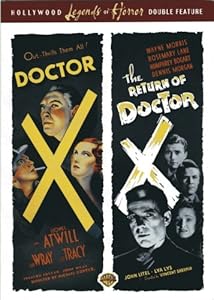
![]() The Return of Doctor X directed by Vincent Sherman
The Return of Doctor X directed by Vincent Sherman
As a result of his breakthrough role as Duke Mantee in the 1936 gem The Petrified Forest, Humphrey Bogart made no fewer than 25 films for Warner Brothers over the course of the next four years: five in 1936, seven (!) in 1937, six in 1938 and another whopping seven in 1939! Talk about paying your dues! For the most part, Bogart was second or even third billed — and even lower — in these films, typically playing gangsters but also some very unlikely roles, and these from the man who, just a few years later still, would be the highest paid actor in Hollywood. But of all the unusual roles that the great Bogart ever essayed, it is the part of Marshall Quesne (pronounced “Kane”) in The Return of Doctor X that just might be his strangest. Bogart would go on to claim that this film, along with 1938’s Swing Your Lady, was his absolute worst, but a recent rewatch of The Return of Doctor X, which was released in December ’39, has served to demonstrate — for this viewer, anyway — that the picture still has lots to offer to the modern-day viewer.
In the film, we meet a young reporter, Walter Garrett, appealingly played, as always, by Wayne Morris (who had already appeared with Bogart in such films as China Clipper, Kid Galahad and Men Are Such Fools). Garrett goes to the apartment of actress Angela Merrova (German actress Lya Lys; love that name!) to conduct an interview, only to find her dead; stabbed in the chest and with her blood drained away. After he calls the cops in, he returns to find the corpse vanished, to his great embarrassment. But the next day, Merrova appears in the newspaper office, very much alive but decidedly pale looking. Understandably confused, and out of a job as a result of this mix-up, Garrett consults his doctor buddy Michael Rhodes (fresh-faced Dennis Morgan), and the two go on to confer with Rhodes’ hospital mentor, Dr. Francis Flegg (John Litel, who had previously appeared with Bogart in Marked Woman, Black Legion, The Amazing Dr. Clitterhouse AND You Can’t Get Away With Murder).
The buddies are somewhat repelled by Flegg’s laboratory assistant, Quesne, with his sweaty, pallid face, oddball demeanor, and streak of white in his otherwise dark hair. As the murders continue, with similar blood drainings, the clues lead invariably toward both Flegg and Quesne. Digging in the newspaper’s morgue, as well as in the local graveyard, and with the assistance of the paper’s gofer Pinky (Huntz Hall, of all people), Garrett and Rhodes learn that Quesne’s real name is Francis Xavier, and that he had once been electrocuted for murder! And before long, Quesne/Xavier has lured pretty nurse Joan Vance (Rosemary Lane, who had appeared with Bogart in The Oklahoma Kid some nine months earlier) into his clutches, to be his next life-sustaining “blood donor”…
The Return of Doctor X, as has been noted elsewhere, has absolutely no relation to Doctor X, which film had been released seven years previous. Return was helmed by Vincent Sherman, who shines in his very first go as director; he would later go on to direct such prestige projects as All Through the Night (a very fine and underrated Bogart film), Old Acquaintance, Mr. Skeffington, and Harriet Craig. Sherman really makes his picture move, and indeed, the final 15 minutes of the 62-minute film proceed at a remarkably rapid and thrilling clip. (Filmmakers today might learn a lesson here on how to make a movie as compact and streamlined as possible, although it is doubtful whether today’s audiences would be willing to pay $15 to see a picture of only one hour’s length!)
Morris and Morgan make for enormously likable gumshoe leads (I could easily see how a whole series of horror/detective films might have been formed around the reporter/doctor pair), and the film dishes out un-embarrassing humor (Garrett takes a few comical pratfalls, and the dialogue between him and his exasperated editor, and him and the chief cop on the case, is priceless) and fairly intelligent thrills in equal proportion. The look of the film itself is very fine, with cinematographer Sid Hickox providing some fairly stunning B&W lensing at times (I love those lab shots, and the many close-ups of Xavier’s demented mug!). As for Bogart, he is truly creepy and effective here, in his one and only sci-fi/horror film; not exactly a vampire, but rather the resuscitated dead, slaying those who might provide him with his very rare blood type. Not surprisingly, by the film’s end, the Bogart character lies on the ground, dying from a gunshot wound, as had so many of his other bad-guy characters of the previous four years. And, as had those other villains, he again gets to deliver some wonderful dying words: “Tell Dr. Rhodes that we’ll have to … postpone our talk on … blood composition…” Love it!



COMMENT Was I hinting that? I wasn't aware of it. But now that you mention it.... 🤔
So it sounds like you're hinting Fox may have had three or so different incomplete stories that he stitched together,…
It's hardly a private conversation, Becky. You're welcome to add your 2 cents anytime!
If the state of the arts puzzles you, and you wonder why so many novels are "retellings" and formulaic rework,…
I picked my copy up last week and I can't wait to finish my current book and get started! I…